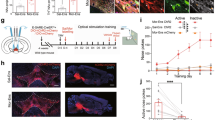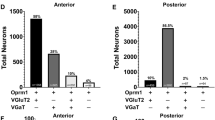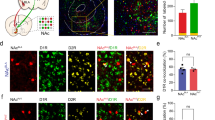Abstract
The neural mechanisms that mediate the transition from a drug-naive state to a state of drug dependence and addiction are not yet known. Here we show that a discrete population of GABAA receptors in the mammalian ventral tegmental area (VTA) serves as a potential addiction switching mechanism by gating reward transmission through one of two neural motivational systems: either a dopamine-independent (opiate-naive) or a dopaminergic (opiate-dependent or opiate-withdrawn) system. Bi-directional transmission of reward signals through this GABAA receptor substrate is dynamically controlled by the opiate state of the organism and involves a molecular alteration of the GABAA receptor. After opiate exposure and subsequent withdrawal, the functional conductance properties of the rat VTA GABAA receptor switch from an inhibitory to an excitatory signaling mode.
This is a preview of subscription content, access via your institution
Access options
Subscribe to this journal
Receive 12 print issues and online access
$209.00 per year
only $17.42 per issue
Buy this article
- Purchase on Springer Link
- Instant access to full article PDF
Prices may be subject to local taxes which are calculated during checkout







Similar content being viewed by others
References
Mark, T.L., Woody, G.E., Juday, T. & Kleber, H.D. The economic costs of heroin addiction in the United States. Drug Alcohol Dep. 61, 195–206 (2001).
Schulteis, G., Heyser, C.J. & Koob, G.F. Opiate withdrawal signs precipitated by naloxone following a single exposure to morphine: potentiation with a second morphine exposure. Psychopharmacology 129, 56–65 (1997).
Vanderschuren, L.J., De Vries, T.J., Wardeh, G., Hogemboom, F.A. & Schoffelmeer, A.N. A single exposure to morphine induces long-lasting behavioural and neurochemical sensitization in rats. Eur. J. Neurosci. 14, 1533–1538 (2001).
Nestler, E.J. Molecular neurobiology of addiction. Am. J. Addict. 10, 201–217 (2001).
Wise, R.A. & Rompre, P.P. Brain dopamine and reward. Annu. Rev. Psychol. 40, 191–225 (1989).
Bechara, A., Nader, K. & van der Kooy. A two-separate motivational systems hypothesis of opioid addiction. Pharmacol. Biochem. Behav. 59, 1–17 (1998).
Berridge, K.C. & Robinson, T.E. What is the role of dopamine in reward: hedonic impact, reward learning, or incentive salience? Brain Res. Rev. 28, 309–369 (1998).
Robinson, T.E. & Berridge, K.C. The neural basis of drug craving: an incentive-sensitization theory of addiction. Brain Res. Rev. 18, 247–291 (1993).
Nader, K. & van der Kooy, D. Deprivation state switches the neurobiological substrates mediating opiate reward in the ventral tegmental area. J. Neurosci. 17, 383–390 (1997).
Olmstead, M.C., Munn, E.M., Franklin, K.B. & Wise, R.A. Effects of pedunculopontine tegmental nucleus lesions on responding for intravenous heroin under different schedules of reinforcement. J. Neurosci. 18, 5035–5044 (1999).
Dockstader, C.L., Rubinstein, M., Grandy, D.K., Low, M.J. & van der Kooy, D. The D2 receptor is critical in mediating opiate motivation only in opiate-dependent and withdrawn mice. Eur. J. Neurosci. 13, 995–1001 (2001).
Gerrits, M., Ramsey, N.F., Wolternink, G. & van Ree, J.M. Lack of evidence for an involvement of the nucleus accumbens dopamine D1 receptors in the initiation of heroin self-administration in the rat. Psychopharmacology 114, 486–494 (1994).
Laviolette, S.R., Nader, K. & van der Kooy, D. Motivational state determines the role of the mesolimbic dopamine system in the mediation of opiate reward processes. Behav. Brain Res. 129, 17–29 (2002).
Robinson, T.E. & Berridge, K.C. The psychology and neurobiology of addiction: an incentive-sensitization view. Addiction 95 (Suppl. 2), S91–S117 (2000).
Garris, P.A. et al. Dissociation of dopamine release in the nucleus accumbens from intracranial self-stimulation. Nature 398, 67–69 (1999).
Laviolette, S.R. & van der Kooy, D. GABAA receptors in the ventral tegmental area control bidirectional reward signalling between dopaminergic and non-dopaminergic neural motivational systems. Eur. J. Neurosci. 13, 1009–1015 (2001).
Semba, K. & Fibiger, H.C. Afferent connections of the laterodorsal and pedunculopontine tegmental nuclei in the rat: a retro and antero-grade transport and immunohistochemical study. J. Comp. Neurol. 323, 387–410 (1992).
Steininger, T.L., Rye, D.B. & Wainer, B.H. Afferent projections to the cholinergic pedunculopontine tegmental nucleus and adjacent midbrain extrapyramidal area in the albino rat. I. Retrograde tracing studies. J. Comp. Neurol. 321, 515–543 (1992).
Steffensen, S.C., Lee, R.S., Stobbs, S.H. & Henriksen, S.J. Responses of ventral tegmental area GABA neurons to brain stimulation reward. Brain Res. 906, 190–197 (2001).
Churchill, L., Dilts, R.P. & Kalivas, P.W. Autoradiographic localization of GABAA receptors within the ventral tegmental area. Neurochem. Res. 17, 101–106 (1992).
Klitenick, M.A., DeWitte, P. & Kalivas, P.W. Regulation of dopamine release in the ventral tegmental area by opioids and GABA: an in vivo microdialysis study. J. Neurosci. 12, 2623–2632 (1992).
Xi, Z.X. & Stein, E.A. Nucleus accumbens dopamine release modulation by mesolimbic GABAA receptors: an in-vivo electrochemical study. Brain Res. 798, 156–165 (1998).
Margreta-Mitrovic, M., Mitrovic, I., Riley, R.C., Jan, L.Y. & Basbaum, A.I. Immunohistochemical localization of GABAB receptors in the rat central nervous system. J. Comp. Neurol. 405, 299–321 (1999).
Kalivas, P.W. Neurotransmitter regulation of dopamine neurons in the ventral tegmental area. Brain Res. Rev. 18, 75–113 (1993).
Kalivas, P.W., Duffy, P. & Eberhardt, H. Modulation of A10 dopamine neurons by gamma-aminobutyric acid agonists. J. Pharmacol. Exp. Ther. 253, 858–867 (1990).
Grace, A.A. & Bunney, B.S. Paradoxical GABA excitation of nigral dopaminergic cells: indirect mediation through reticulata inhibitory neurons. Eur. J. Pharmacol. 59, 211–218 (1979).
Stinus, L., Herman, J.P. & LeMoal, M. GABAergic mechanisms within the ventral tegmental area: involvement of dopaminergic (A10) and non-dopaminergic neurons. Psychopharmacology 77, 186–192 (1982).
Creese, I., Burt, D.R. & Snyder, S.H. Dopamine receptor binding predicts clinical and pharmacological potencies of antischizophrenic drugs. Science 192, 481–483 (1976).
Laviolette, S.R. & van der Kooy, D. Blockade of mesolimbic dopamine receptors dramatically potentiates the rewarding effects of nicotine in the ventral tegmental area. Mol. Psychol. 8, 50–59 (2003).
Mackey, W.B. & van der Kooy, D. Neuroleptics block the positive reinforcing effects of amphetamine but not of morphine as measured by place conditioning. Pharm. Biochem. Behav. 22, 101–106 (1985).
Brebner, K., Phelan, R. & Roberts, D.C.S. Intra-VTA baclofen attenuates cocaine self-administration on a progressive ratio schedule. Pharmacol. Biochem. Behav. 66, 857–862 (2000).
Westerink, B.H.C., Kwint, J.B. & DeVries, J.B. The pharmacology of mesolimbic dopamine neurons: a dual-probe microdialysis study in the ventral tegmental area and nucleus accumbens of the rat brain. J. Neurosci. 16, 2605–2611 (1996).
Staley, K.J., Soldo, B. & Proctor, W. Ionic mechanisms of neuronal excitation by inhibitory GABAA receptors. Science 269, 977–981 (1995).
Auger, A.P., Perrot-Sinal, T.S. & McCarthy, M.M. Excitatory versus inhibitory GABA as a divergence point in steroid-mediated sexual differentiation of the brain. Proc. Natl. Acad. Sci. USA 98, 8059–8064 (2001).
Borsook, D., Smirnova, O., Behar, O., Lewis, S. & Kobierski, L.A. PhosphoCREB and CREM/ICER: positive and negative regulation of proenkephalin gene expression in the paraventricular nucleus of the hypothalamus. J. Mol. Neurosci. 12, 35–51 (1999).
Steffensen, S.C., Svingos, A.L., Pickel, V.M. & Henriksen, S.J. Electrophysiological characterization of GABAergic neurons in the ventral tegmental area. J. Neurosci. 18, 8003–8015 (1998).
Van Bockstaele, E.J. & Pickel, V.M. GABA-containing neurons in the ventral tegmental area project to the nucleus accumbens in rat brain. Brain Res. 682, 215–221 (1995).
Swanson, L.W. The projections of the ventral tegmental area and adjacent regions: a combined flourescent retrograde tracer and immunoflourescence study. Brain Res. Bull. 9, 321–353 (1982).
Olpe, H.R., Koella, W.P., Wolf, P. & Haas, H.L. The action of baclofen on neurons of the substantia nigra and of the ventral tegmental area. Brain Res. 134, 577–580 (1977).
Johnston, S.W. & North, R.A. Opioids excite dopamine neurons by hyperpolarization of local interneurons. J. Neurosci. 12, 483–488 (1992).
Gysling, K. & Wang, R.Y. Morphine-induced activation of A10 dopamine neurons in the rat. Brain Res. 277, 119–127 (1983).
Garzon, M. & Pickel, V.M. Plasmalemmal mu-opioid receptor distribution mainly in non-dopaminergic neurons in the rat ventral tegmental area. Synapse 41, 311–328 (2001).
Svingos, A.L., Garzon, M., Colago, E.E.O. & Pickel, V.V. Mu-opioid receptors in the ventral tegmental area are targeted to presynaptically and directly modulate mesocortical projection neurons. Synapse 41, 221–229 (2001).
Bonci, A. & Williams, J.T. Increased probability of GABA release during withdrawal from morphine. J. Neurosci. 17, 796–803 (1997).
Cohen, I., Navarro, V., Clemenceau, S., Baulac, M. & Miles, R. On the origin of interictal activity in human temporal lobe epilepsy in vitro. Science 298, 1418–1421 (2002).
Wagner, S., Castel, M., Gainer, H. & Yarom, Y. GABA in the mammalian suprachiasmatic nucleus and its role in diurnal rhythmicity. Nature 387, 598–603 (1997).
Coggeshal, R.E. & Lekan, H.A. Methods for discriminating numbers of cells and synapses: a case for more uniform standards of review. J. Comp. Neurol. 364, 6–15 (1996).
Acknowledgements
This work was supported by the Canadian Institutes of Health Research.
Author information
Authors and Affiliations
Corresponding author
Ethics declarations
Competing interests
The authors declare no competing financial interests.
Rights and permissions
About this article
Cite this article
Laviolette, S., Gallegos, R., Henriksen, S. et al. Opiate state controls bi-directional reward signaling via GABAA receptors in the ventral tegmental area. Nat Neurosci 7, 160–169 (2004). https://doi.org/10.1038/nn1182
Received:
Accepted:
Published:
Issue Date:
DOI: https://doi.org/10.1038/nn1182
This article is cited by
-
Ventral tegmental area glutamate neurons establish a mu-opioid receptor gated circuit to mesolimbic dopamine neurons and regulate opioid-seeking behavior
Neuropsychopharmacology (2023)
-
Prolonged abstinence from cocaine or morphine disrupts separable valuations during decision conflict
Nature Communications (2018)
-
Blocking microglial pannexin-1 channels alleviates morphine withdrawal in rodents
Nature Medicine (2017)
-
Glial and Neuroimmune Mechanisms as Critical Modulators of Drug Use and Abuse
Neuropsychopharmacology (2017)
-
Formation of aversive memories associated with conditioned drug withdrawal requires BDNF expression in the amygdala in acute morphine-dependent rats
Acta Pharmacologica Sinica (2015)



